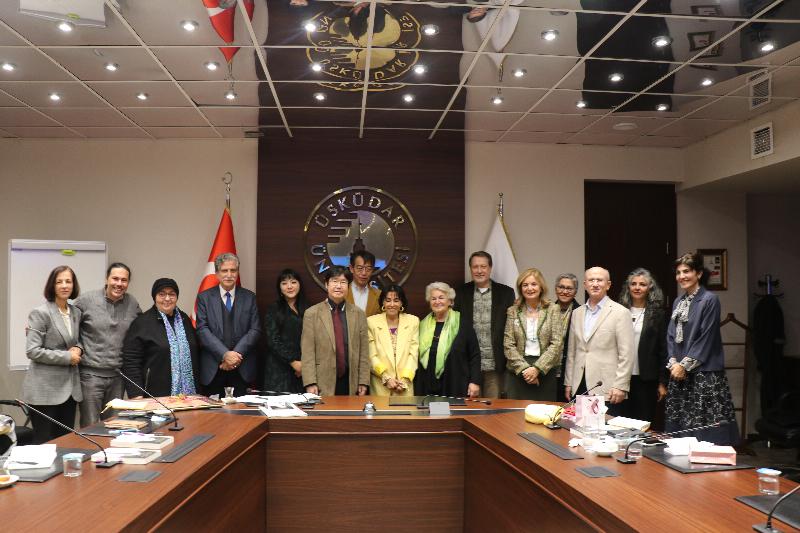“Comprehensive Study of Sufism: Through Metaphysics, Literature, Music and Rituals”
The project “Comprehensive Study of Sufism: Through Metaphysics, Literature, Music and Rituals”, in partnership with Üsküdar University Institute for Sufi Studies, and under the direction of the Graduate School of Asian and African Area Studies ASAFAS, Kyoto University, has been supported as of 2021 by The Japan Society for the Promotion of Science (JSPS) organization. Project Coordinator, Kyoto University, ASAFAS Kyoto Kenan Rifai Center for Sufi Studies Director is Prof. Yasushi Tonaga. The project is planned as a 6-year study and the project budget is 19.600.000 JPY (1.525.000 TL). There is no financial demand from our University as a project partner, and academic support is planned within the scope of our Institute.

Yürütücü Kurum: Kyoto Üniversitesi
Proje Yürütücüsü:
Yasushi Tonaga
Masayuki Akahori
Manami Suzuki
Proje Ortağı Kuruluş:
T.C. Üsküdar Üniversitesi Tasavvuf Araştırmaları Enstitüsü
Kurum Temsilcisi:
Elif Erhan
Emine Yeniterzi
Dilek Güldütuna
Cangüzel Güner Zülfikar
Reşat Öngören
Arzu Eylül Yalçınkaya
Omneya Ayad
Comprehensive Study of Sufism: Through Metaphysics, Literature, Music and Rituals
About the contributions of the Institute for Sufi Studies, Üsküdar University:
Draft Schedule for March 22, 2022-2024
The Mawlawi rituals’ aim is to design and guide the wayfarers’ inner (batin) and outer (zahir) experiences. They provide the foundation for the life style and worldview of Mawlawis.
Mawlawi rituals are imbued with very dense symbolism. Particularly the sama’ ceremony which was organized by Sultan Veled, the son of Mawlana, is considered as the representation of the galaxies and therefore both macro-cosmos and micro-cosmos can be found in the rituals of the Mawlawi order.
Mawlawiyya impacted the Ottoman Sufi thought strongly, based on the principle of the Divine Love.
Mawlawi training can be found even in the daily language, word choices are very good examples, i.e. Mawlawis usually say certain idioms “waking up the lights” instead of “opening lights”, or “letting lights to rest” instead of “closing lights”, etc. They even kiss their water cups in order to show their appreciation and respect to the vessels, which are in their services.
These principles shaped Ottoman civilization, especially through institutions and their functions in society. Shaping human and humans’ role in society is inherent to Sufi thought and Mawlawi metaphysics. This is summarized in the maxim “serving people is to serve God”.

Mawlawiyya: Emergence and resources
Geography of Mawlawiyya and Spread of Mawlawiyya
Spiritual Training in the Mawlawiyya
Mawlawi Architecture – Mawlawi Lodges
Whirling Ceremony
Mawlawi Music
Calligraphy in Mawlawiyya and Mawlawi Calligraphers
Painting in Mawlawiyya and Mawlawi Painters
Mawlawi Clothing
Mawlawi Literature — Mawlawi Poets, Sources of Mawlawi Literature
Mathnawi and the Place of Mathnawi in Sufi Tradition
Mathnawi Commentaries
Stories in the Mathnawi
Teachings and Concepts in the Mathnawi (human, love, patience, repentance, etc.)
Metaphysics of Mawlana: Divine Love
Mawlana’s understanding of sufism is based firmly in Divine Love. According to him, love is the source, impulse and aim of all divine and mortal actions. A human beginning on the path of truth (haqiqa), progressing on that path and eventually joining Haqq is only possible through love. In the history of Sufism, Ahmed Gazzali (d. 520/1126) was the first to comprehensively take up the matter of divine love, followed by figures such as Ayn al-Qudat Hamadani, Senâî Ghaznavî, Ruzbihan Baqlî, Fariduddin Attar, Ibn al-Farid until eventually reaching Mawlana. The translations and commentaries done on the Mathnawi greatly influenced Ottoman Sufi thought; this understanding continues today.
Goal of Sufism is training human. With this goal, rituals that teach the beautiful conduct of the Prophet, unity, love, aesthetics, ilm (knowledge), etc. became an important part of life in the lodges.
Arts and aesthetics effects on human psychology (both for materialistic and spiritual feelings of human beings),
Connections to different areas of arts such as music, poetry, dance, and clothing,
A space where the conduct of the order must be applied such as relations with the murshid (teacher), relations between the disciples (dervishes), hierarchy within the order, participant observers, outside listeners, the social aspect.
The functions of the space of the lodges in society (training, school, recollection, sama' [whirling], architecture),
A space for and use of accoutrements of the order; prayer rugs, prayer beads, dervish trousseau: clothing, flags (sancaklar), musical instruments (bendir, halile, teber, topuz).
The depth of symbolism to each of these directly connects sufism and symbolism.
Comparative research on Shintoism, Buddhism, and Islam in terms of Mawlawi metaphysics. There might be common points about reaching the pure heart, worldview, and rituals.
Comparative study on the spiritual themes in Shikibu’s “The Tale of Genji” and “The Thousand and One Nights” and identify whether there are certain influences and intertextual characteristics between these two important pieces of world literature.
Comparative study on the concept of Indra’s Net in “Avamtasaka Sutra” and how this concept has similar reflections in the Sufi tradition, such as “Wahdat al-wujud” (Unity of existence).
Comparative study on the classical Japanese dance-drama “Noh Theater” with Ottoman traditional shadow play “Karagöz and Hacivat”.

